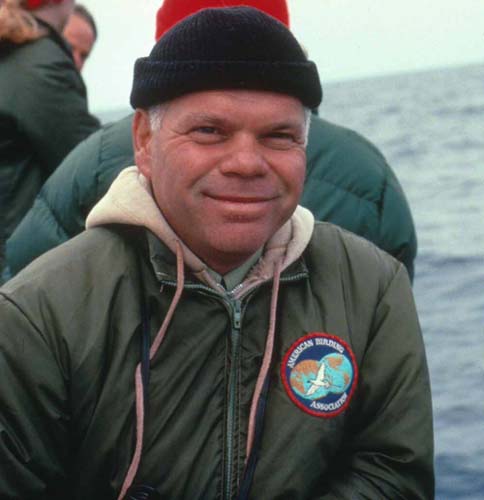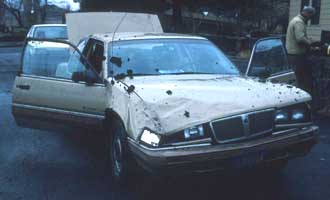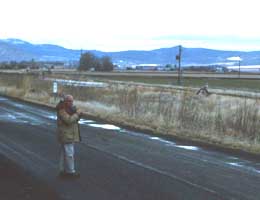IN MEMORIAM: ARNOLD SMALL
1926-2000
 Arnold Small was larger than life. Not only was he a major name in the
California birding world over the past half century, but to those of us
who knew him well he was just a great guy. He was always full of energy,
confidence, generosity, and good humor. I had the good fortune to become
a friend over the last 25 years, and am a much enriched person because
of it.
Arnold Small was larger than life. Not only was he a major name in the
California birding world over the past half century, but to those of us
who knew him well he was just a great guy. He was always full of energy,
confidence, generosity, and good humor. I had the good fortune to become
a friend over the last 25 years, and am a much enriched person because
of it.
Every autumn, Arnold and Herb & Olga Clarke would journey to Monterey
to do a boat trip, often in connection with Arnold's UCLA. They often stayed
at my home or, should they opt for a motel, we always got together for
an evening of dinner and stories about the birding world. Arnold and Herb
exist in the realm of world class photographers, and Arnold would often
bring his latest show. Indeed, his "Birding Planet Earth" show (which not
only did I see at my home but several times on the lecture circuit) is
probably my all-time favorite bird slide show.
Arnold was among the front-runners chasing California birds in the '70s
and '80s, and I'd often run into him (plus Herb & Olga and sometime
Bruce Broadbooks or Larry Sansone; they often traveled as a pack) at some
remote locale chasing some great bird. One of the most memorable was in
January 1986. After a small flock of Common Redpoll was found near Tule
Lake up on the Oregon border, Arnold, Herb & Olga flew to Klamath Falls,
Oregon, and rented a car. They were up before dawn, driving the icy roads
to get to the site early. In the bitter cold they hit a patch of "black
ice" and flipped the car, rolling it over completely and landing back upright.
Shaken but undeterred -- after all this was the first chaseable Common
Redpoll in the state! -- they continued on. Just a few of us were there
when they arrived in a badly banged up rental (below left). But getting
his priorities straight, Arnold was out and looking for the birds immediately
(below right). [We all added the redpolls to our state list that day.]


Arnold was just like that -- undaunted, unruffled, and full of energy.
His creativity made him a great teacher, although I know very little about
that side of his world. But he was full of ideas and dreams and ambitions.
Sometimes he may have stretched too far, but I always admired his efforts
to go where no one yet had yet been.
Arnold was also a great storyteller. Obviously he did a lot of birding
in California, but I was probably more interested in his tales about birding
the world. He was always way ahead of me -- not only in seeing life
birds but in knowing when and how to get them. In the days before the rise
of professional bird tour companies, his expertise was beyond value. And
he was generous in sharing what he knew. He was among my early mentors
in taking up the quest to see birds around the world, and he wrote an important
article when he had just seen his 4000th lifer (White-headed Piping-Guan
in Surinam), an achievement that at the time represented seeing nearly
half of the birds of the world. It originally appeared in the Los Angeles
Audubon Society newsletter Western Tanager (May 1976) and was reprinted
in Birding 8: 145-148 (1976). It concludes with this thought:
"Collecting" new families is as gratifying to me as seeing
new species -- only much more difficult. In fact, there is only one order
of the 28 living orders of birds that I have not yet met in the wild --
and that is the Rheas. But when the great day finally dawns that I see
my first wild Rhea, it will be like number 1 or number 4,000 all over again,
only more so -- for the Rhea will represent not only a new species,
but a new family, and a new order -- in short, a brand new
bird in the fullest sense of the world. And for me, I know, finding
that bird will be one more incredible thrill in a lifetime of exciting
adventures in birding.
Arnold, of course, saw his rhea and many, many more great birds (at the
end of 1997, the ABA list report had him at well over 6500 species). He
(and Stuart Keith) might be considered the inspiration for this web site
on bird families of the world.
Arnold was president of the American Birding Association in its early
glory days, and was in the forefront of promoting birding as a great avocation
[Stuart Keith wrote a great short introduction to his presidency in Birding
8: 217-218 (1976)]. Some of the best times I've ever had in the bird world
were at ABA Conventions in the 1970s when, invited to a room hosted by
Arnold or Stuart Keith or Bob Smart, I could just take in the wonderful
world of birding possibilities by listening to them swap anecdotes and
tall tales. Good-natured ribbing was always a part of these scenes -- indeed,
birding was just FUN for them. This joy was liberally spread to anyone
who cared to listen. [In contrast, I see way too much heavy-handed seriousness
in some of today's top birders who, quick to criticize, just seem always
gloomy -- whereas Arnold always seemed to be having fun.]
And Arnold always had new tales to tell of new places and adventures.
Just a couple years back, he and Jim Clements headed off to New Caledonia,
home to one of the world's best birds, the unique Kagu. Now the Kagu had
been a mythical beast that no one had seen for decades and which had almost
gone extinct. It was thought to be nocturnal and hopeless to locate. But
Jim & Arnold got the line that it might be found again with the help
of Yves Letocart whose work on Kagu biology and predator reduction in its
habitat had brought it back from the brink. They made the effort to get
there and find out. Not only did Arnold & Jim find the Kagu -- but
they found it during the day (!) and got fantastic photos! As far as I
know, they were the first world birders to see the Kagu without a tour,
without a tape, and during the day! When I saw Arnold's slides I felt I
absolutely had to get there myself. Arnold & Jim were generous with
information and, the next year, Rita and I did get there and followed in
their giant footsteps to see the Kagu. Arnold was my inspiration for that
and many other great adventure (indeed, he organized the trip to Gabon
on which we saw rockfowl but he himself had to drop out for medical reasons).
Yes, in all things it seemed to me that Arnold had his priorities straight.
He took superb photos; he told the best stories; and he had a wonderful
time with life. That's the Arnold Small that I remember, and that I will
very much miss.
by Don Roberson
PHOTOS: J. Van Remsen took the great
shot of Arnold on a Monterey Bay boat trip in September 1976 (top); the
other two shots were near Tule Lake NWR, Siskiyou Co., California, on 4
Jan 1986.
Photos © 2000 J. Van Remsen (used with permission)
and D. Roberson, all rights reserved.
TOP
GO TO LIST OF FAMILIES
OF THE WORLD
RETURN TO HOME
PAGE
GO TO BIRDING THE
WORLD
Page created 8 Feb 2000
 Arnold Small was larger than life. Not only was he a major name in the
California birding world over the past half century, but to those of us
who knew him well he was just a great guy. He was always full of energy,
confidence, generosity, and good humor. I had the good fortune to become
a friend over the last 25 years, and am a much enriched person because
of it.
Arnold Small was larger than life. Not only was he a major name in the
California birding world over the past half century, but to those of us
who knew him well he was just a great guy. He was always full of energy,
confidence, generosity, and good humor. I had the good fortune to become
a friend over the last 25 years, and am a much enriched person because
of it.

